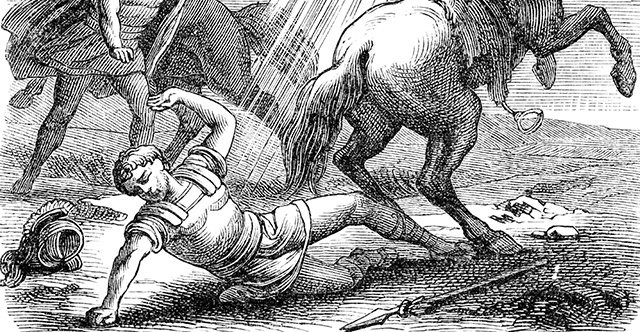
1
Î
n prima zi a săptămânii, Maria Magdalena a venit la mormânt dis-de-dimineaţă, când încă era întuneric, şi a văzut că piatra fusese luată de pe mormânt.
Now on the first day of the week, Mary Magdalene came to the tomb early, while it was still dark, and saw that the stone had been removed from (lifted out of the groove across the entrance of) the tomb.
2
A
alergat şi a venit la Simon Petru şi la celălalt ucenic, cel pe care-l iubea Isus, şi le-a zis: „L-au luat pe Domnul din mormânt şi nu ştim unde L-au pus!“
So she ran and went to Simon Peter and the other disciple, whom Jesus loved, and said to them, They have taken away the Lord out of the tomb, and we do not know where they have laid Him!
3
A
tunci Petru şi celălalt ucenic au ieşit şi s-au dus la mormânt.
Upon this, Peter and the other disciple came out and they went toward the tomb.
4
C
ei doi au început să alerge împreună, dar celălalt ucenic a alergat mai repede decât Petru şi a ajuns primul la mormânt.
And they came running together, but the other disciple outran Peter and arrived at the tomb first.
5
C
ând s-a aplecat să se uite înăuntru, a văzut fâşiile de pânză întinse pe jos, dar n-a intrat.
And stooping down, he saw the linen cloths lying there, but he did not enter.
6
S
imon Petru, care îl urma, a ajuns şi el; a intrat în mormânt şi a văzut fâşiile de pânză întinse pe jos,
Then Simon Peter came up, following him, and went into the tomb and saw the linen cloths lying there;
7
d
ar ştergarul care fusese pe capul lui Isus nu era pus împreună cu fâşiile de pânză, ci era împăturit şi aşezat într-un loc separat.
But the burial napkin (kerchief) which had been around Jesus’ head, was not lying with the other linen cloths, but was rolled up (wrapped round and round) in a place by itself.
8
A
tunci celălalt ucenic, care ajunsese primul la mormânt, a intrat şi el, a văzut şi a crezut.
Then the other disciple, who had reached the tomb first, went in too; and he saw and was convinced and believed.
9
C
ăci tot nu înţeleseseră Scriptura, potrivit căreia El trebuia să învie dintre cei morţi.
For as yet they did not know (understand) the statement of Scripture that He must rise again from the dead.
10
A
poi ucenicii s-au întors acasă. Isus i Se arată Mariei Magdalena
Then the disciples went back again to their homes (lodging places).
11
M
aria însă stătea afară, lângă mormânt, şi plângea. În timp ce plângea, s-a aplecat să se uite în mormânt
But Mary remained standing outside the tomb sobbing. As she wept, she stooped down into the tomb.
12
ş
i a văzut doi îngeri îmbrăcaţi în alb, şezând unul la cap şi unul la picioare în locul unde fusese pus trupul lui Isus.
And she saw two angels in white sitting there, one at the head and one at the feet, where the body of Jesus had lain.
13
E
i au întrebat-o: – Femeie, de ce plângi? Ea le-a răspuns: – Pentru că L-au luat pe Domnul meu şi nu ştiu unde L-au pus!
And they said to her, Woman, why are you sobbing? She told them, Because they have taken away my Lord, and I do not know where they have laid Him.
14
D
upă ce a spus acestea, s-a întors şi L-a văzut pe Isus stând acolo, dar nu ştia că este Isus.
On saying this, she turned around and saw Jesus standing, but she did not know (recognize) that it was Jesus.
15
I
sus a întrebat-o: – Femeie, de ce plângi? Pe Cine cauţi? Crezând că este grădinarul, ea I-a zis: – Domnule, dacă Tu L-ai luat, spune-mi unde L-ai pus şi eu Îl voi lua!
Jesus said to her, Woman, why are you crying ? For Whom are you looking? Supposing that it was the gardener, she replied, Sir, if you carried Him away from here, tell me where you have put Him and I will take Him away.
16
–
Maria! i-a zis Isus. Ea s-a întors şi I-a zis în aramaică: – Rabbuni! – care înseamnă: „Învăţătorule!“.
Jesus said to her, Mary! Turning around she said to Him in Hebrew, Rabboni!—which means Teacher or Master.
17
I
sus i-a zis: – Nu Mă ţine, pentru că încă nu M-am suit la Tatăl! Du-te însă la fraţii Mei şi spune-le: „Mă sui la Tatăl Meu şi Tatăl vostru, la Dumnezeul Meu şi Dumnezeul vostru!“
Jesus said to her, Do not cling to Me, for I have not yet ascended to the Father. But go to My brethren and tell them, I am ascending to My Father and your Father, and to My God and your God.
18
M
aria Magdalena s-a dus şi i-a anunţat pe ucenici: „L-am văzut pe Domnul!“ şi că El i-a spus aceste lucruri. Isus li Se arată ucenicilor
Away came Mary Magdalene, bringing the disciples news (word) that she had seen the Lord and that He had said these things to her.
19
Î
n seara acelei zile, prima zi a săptămânii, în timp ce acolo unde se aflau ucenicii uşile erau încuiate de frica iudeilor, Isus a venit, a stat în mijlocul lor şi le-a zis: „Pace vouă!“
Then on that same first day of the week, when it was evening, though the disciples were behind closed doors for fear of the Jews, Jesus came and stood among them and said, Peace to you!
20
Ş
i spunând aceasta, le-a arătat mâinile şi coasta Lui. Ucenicii s-au bucurat când L-au văzut pe Domnul.
So saying, He showed them His hands and His side. And when the disciples saw the Lord, they were filled with joy (delight, exultation, ecstasy, rapture).
21
I
sus le-a zis din nou: „Pace vouă! Aşa cum M-a trimis pe Mine Tatăl, aşa vă trimit şi Eu pe voi!“
Then Jesus said to them again, Peace to you! as the Father has sent Me forth, so I am sending you.
22
Ş
i spunând aceasta, a suflat peste ei şi le-a zis: „Luaţi Duh Sfânt!
And having said this, He breathed on them and said to them, Receive the Holy Spirit!
23
C
elor ce le veţi ierta păcatele, vor fi iertate, iar celor ce le veţi ţine, vor fi ţinute.“
'> led and directed by Him] if you forgive the sins of anyone, they are forgiven; if you retain the sins of anyone, they are retained.
24
Î
nsă Toma, unul dintre cei doisprezece, cel numit „Didimus“, nu era cu ei când a venit Isus.
But Thomas, one of the Twelve, called the Twin, was not with them when Jesus came.
25
C
eilalţi ucenici i-au zis: – L-am văzut pe Domnul! Dar el le-a zis: – Dacă nu văd semnul cuielor în mâinile Lui, dacă nu pun degetul meu în semnul cuielor şi dacă nu pun mâna mea în coasta Lui, nu voi crede! Isus i Se arată lui Toma
So the other disciples kept telling him, We have seen the Lord! But he said to them, Unless I see in His hands the marks made by the nails and put my finger into the nail prints, and put my hand into His side, I will never believe.
26
D
upă opt zile, ucenicii erau din nou înăuntru, iar Toma era cu ei. Pe când uşile erau încuiate, a venit Isus, a stat în mijlocul lor şi le-a zis: „Pace vouă!“
Eight days later His disciples were again in the house, and Thomas was with them. Jesus came, though they were behind closed doors, and stood among them and said, Peace to you!
27
A
poi i-a zis lui Toma: – Adu-ţi degetul aici şi priveşte-Mi mâinile! Adu-ţi mâna şi pune-o în coasta Mea! Şi nu fi necredincios, ci credincios!
Then He said to Thomas, Reach out your finger here, and see My hands; and put out your hand and place in My side. Do not be faithless and incredulous, but believe!
28
T
oma I-a răspuns: – Domnul meu şi Dumnezeul meu!
Thomas answered Him, My Lord and my God!
29
I
sus i-a zis: – Ai crezut pentru că M-ai văzut? Ferice de cei ce n-au văzut şi au crezut! Scopul scrierii acestei cărţi
Jesus said to him, Because you have seen Me, Thomas, do you now believe (trust, have faith)? Blessed and happy and to be envied are those who have never seen Me and yet have believed and adhered to and trusted and relied on Me.
30
I
sus a mai făcut multe alte semne înaintea ucenicilor Săi, semne care nu sunt scrise în această carte.
There are also many other signs and miracles which Jesus performed in the presence of the disciples which are not written in this book.
31
Î
nsă acestea au fost scrise pentru ca voi să ajungeţi să credeţi că Isus este Cristosul, Fiul lui Dumnezeu, şi crezând, să aveţi viaţă în Numele Lui.
But these are written (recorded) in order that you may believe that Jesus is the Christ (the Anointed One), the Son of God, and that through believing and cleaving to and trusting and relying upon Him you may have life through (in) His name '> through Who He is].
 Romanian
Romanian
 Albanian - Shqip
Albanian - Shqip
 Arabic - العربية
Arabic - العربية
 Bulgarian - Български
Bulgarian - Български
 Chinese - 汉语
Chinese - 汉语
 English - English
English - English
 French - Français
French - Français
 German - Deutsch
German - Deutsch
 Italian - Italiano
Italian - Italiano
 Māori - Te Reo Māori
Māori - Te Reo Māori
 Portuguese - Português
Portuguese - Português
 Romanian - Română
Romanian - Română
 Russian - Русский
Russian - Русский
 Somali - Af Soomaali
Somali - Af Soomaali
 Spanish - Español
Spanish - Español
 Ukrainian - Українська
Ukrainian - Українська
 Vietnamese - Tiêng Viêt
Vietnamese - Tiêng Viêt
 English
English
 Albanian - Shqip
Albanian - Shqip
 Arabic - العربية
Arabic - العربية
 Bulgarian - Български
Bulgarian - Български
 Chinese - 汉语
Chinese - 汉语
 English - English
English - English
 French - Français
French - Français
 German - Deutsch
German - Deutsch
 Italian - Italiano
Italian - Italiano
 Māori - Te Reo Māori
Māori - Te Reo Māori
 Portuguese - Português
Portuguese - Português
 Romanian - Română
Romanian - Română
 Russian - Русский
Russian - Русский
 Somali - Af Soomaali
Somali - Af Soomaali
 Spanish - Español
Spanish - Español
 Ukrainian - Українська
Ukrainian - Українська
 Vietnamese - Tiêng Viêt
Vietnamese - Tiêng Viêt
